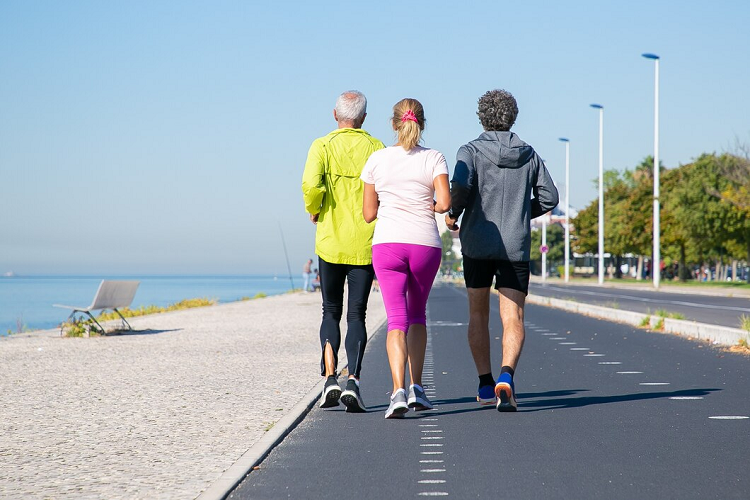Walking can be overlooked in a world where the buzz around wellness often centers on high-intensity workouts and complex diets. However, for seniors, wellness walks are not just a breath of fresh air but a gateway to a healthier, more vibrant life. This guide delves into the transformative power of wellness walks for seniors, exploring their myriad health benefits and offering practical tips for making the most of these serene strolls.

Embracing Wellness Walks for Enhanced Health
The first step towards embracing wellness walks is understanding their significance. For seniors, regular walking is more than just a leisurely activity; it’s a foundational exercise that bolsters physical and mental health. Engaging in wellness walks helps maintain cardiovascular health, improve muscle strength, and enhance flexibility. This gentle exercise is especially beneficial for those who may find more strenuous activities challenging. Walking is incredibly accessible. It doesn’t require special equipment or a gym membership. Whether it’s a stroll in the park, a meander along a nature trail, or a walk in a quiet neighborhood, moving steadily at one’s own pace is empowering and rejuvenating.
The Power of Proper Footwear
One key aspect of making wellness walks beneficial and comfortable, especially for seniors, involves choosing the right footwear. Seniors often face the challenge of swollen feet, a common issue that can make walking uncomfortable. However, the right pair of shoes can make a significant difference. Shoes for swollen feet should offer ample space, adjustable fittings, and good support to ensure comfort and stability during walks. Selecting the right shoes enhances the walking experience, prevents injuries, and supports overall foot health. Comfortable, well-fitting shoes are essential in turning wellness walks into a regular, enjoyable part of a senior’s routine. With the proper footwear, each step becomes a stride towards better health and well-being.
The Therapeutic Benefits of Outdoor Walks
The beauty of wellness walks lies not only in the physical movement but also in the surroundings. Walking outdoors exposes seniors to the therapeutic effects of nature. The fresh air, the tranquility of natural surroundings, and the stimulation of the senses contribute to peace and mental clarity. Studies have shown that spending time in nature can reduce stress, alleviate symptoms of depression, and improve mood. For seniors, these mental health benefits are particularly important. The gentle, rhythmic nature of walking, combined with the calming influence of natural environments, makes wellness walks a powerful tool for maintaining mental and emotional well-being.
In addition to the mental health benefits, walking in nature provides sensory stimulation that can enhance cognitive function. Observing the changing scenery, listening to the sounds of wildlife, and feeling the varying textures of the ground underfoot can keep the mind engaged and alert. As seniors immerse themselves in the beauty of the outdoors, they reap the rewards of sunlight exposure. Sunlight is a natural source of Vitamin D, essential for bone health and immune function. However, it’s important to balance sun exposure with protective measures, such as wearing a hat and applying sunscreen, to safeguard against potential harm from UV rays.
The Mind-Body Connection in Wellness Walks
Wellness walks are not merely physical exercises but a harmonious blend of mind and body benefits. For seniors, this synergy is particularly crucial. As they walk, they engage their muscles, joints, minds, and spirits. The rhythmic nature of walking fosters a meditative state, allowing seniors to clear their minds and find inner peace. This meditative aspect can reduce anxiety and promote a sense of well-being. The repetitive action of walking and the opportunity to reflect or simply enjoy the moment offers a unique form of mental relaxation and clarity.
Physically, the benefits continue to stack up. Regular walking helps maintain joint flexibility and can alleviate Arthritis symptoms, a common concern among the elderly. By keeping the joints in motion, walking ensures better mobility and reduces the risk of joint stiffness and pain. The act of walking helps enhance balance and coordination. This is particularly important for seniors, as it can reduce the risk of falls and injuries. By regularly engaging in walking exercises, seniors can improve their proprioception – the body’s ability to sense its position in space, which is vital for maintaining balance and avoiding accidents.
Additionally, wellness walks contribute to better sleep patterns. Regular physical activity, like walking, is known to improve sleep quality, helping seniors fall asleep faster and enjoy deeper, more restorative rest. This, in turn, boosts overall energy levels and enhances daytime alertness.
Building Community Through Walking Groups
Walking doesn’t have to be a solitary activity. Joining a walking group or inviting friends and family members can add a rich social dimension to wellness walks. For seniors, this social interaction is invaluable. It provides a sense of community and belonging, crucial for mental and emotional health. Walking groups offer a platform for seniors to connect with peers, share experiences, and offer mutual support. These groups can also serve as a source of motivation, encouraging regular participation and helping seniors stay committed to their walking routine. The social aspect of walking also extends to family involvement. When family members join in, it creates an opportunity for intergenerational bonding and learning. It allows younger family members to engage with seniors meaningfully and actively, fostering understanding and strengthening family ties.
Wellness walks offer many benefits for seniors, from physical and mental health improvements to social engagement and community building. By stepping out and embracing the simple yet profound act of walking, seniors can significantly enhance their quality of life and achieve a healthier, more fulfilling future.


